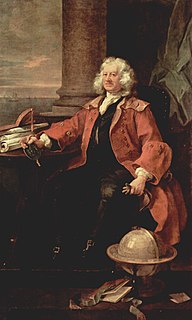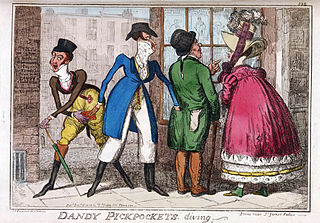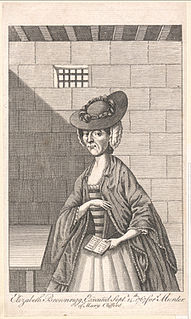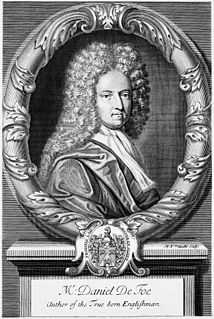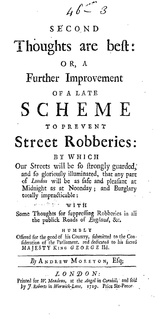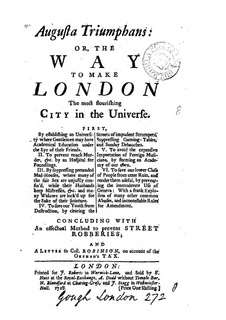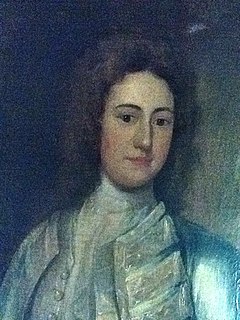History
Etymology
Etymologically speaking, the word "blackguard" seems to have undergone a change between the 16th and the 18th centuries. Originally spelled as two different words, "black" plus "guard", it was eventually used as a single word to indicate those attendants or servants who were in charge of the kitchens, or perhaps black-liveried personal guards. The offensive meaning of "scoundrel", "villain", or any other term which might have suggested the person in question belonged to the criminal world dates back to the late 1730s. Starting from 1784, it was also used as an adjective meant to indicate people of "worthless character" and low social status, such as camp followers and vagabonds. [4] [5] [6]
Background
In the first decades of the 18th century, London stood out among other European cities for its beauty and maintenance, but it nonetheless had to deal with the utter poverty a huge portion of its inhabitants struggled with. [7] Many people couldn't even afford a proper accommodation for the night, and would either spend the little they had gained during the day through begging and charity to pay for disreputable lodgings or find shelter in barns, haylofts and stables to avoid sleeping rough. [8] In 1796, a survey of the streets of London recorded the existence of more than two thousand adults (mostly women) and three hundred children whose only way of living was begging; [9] London was full of places for them to hide and this enabled them to maintain such a lifestyle for a long time, sometimes even years. [10] Living on the streets and the necessity of surviving any way they could brought paupers and vagrants to engage themselves in a wide range of unregulated occupations, from the illegal ones such as prostitution, to temporary employments as chimney or crossing-sweepers, food sellers, shoeblacks or milkmaids. [11] Many simply sold what they managed to collect on the streets, changed their trade according to different seasons and circumstances, and sometimes took advantage of their professions to obtain charity through their labour, approaching passers-by, begging and pickpocketing. [12] The position they occupied was thus an ambiguous one, set somewhere between mendicancy and service. This was the fate of many children, sometimes not even orphans, but illegitimate children born out of wedlock. What they had in common was that there was no one left to care for them: they were reduced to wearing rags, were food deprived, and gangs were sometimes able to provide that support they lacked, even if joining one usually meant turning to crime. [13] Daniel Defoe describes them as likely to die young, either because of rough weather conditions or starvation. [14]
The case of Thomas Coleman
Thomas Coleman, aged 11 or 12, was arrested on 4 November 1730 for stealing two dowlas shirts, while his accomplice managed to escape. Forced to a confession, he decided to turn king's evidence, thus providing Justice George Wellham with a detailed list of both crimes and accomplices. [15] Though such an eager deposition was probably meant to avoid prosecution, he was eventually brought to trial at the Old Bailey anyway, and acquitted on 15 January 1731, [16] but in the meantime he had managed to expose an organized criminal gang led by Katherine Collins. Coleman named at least 14 other boys lodging with him in her house, and explained how she forced them all to steal whatever came to hand. She would then buy the stolen items, and refused to give them shelter, were they to come back empty-handed. [17] They would then lay in the near glass house, which Defoe describes in his Colonel Jack:
Those who know the position of the glass houses, and the arches where they neal the bottles after they are made (...), know that those places where the ashes are cast, and where the poor boys lie, are cavities in the brick-work, perfectly close, except at the entrance, and consequently warm. [18]
Within a few years, most of them were caught and faced several different punishments, for either stealing, housebreaking or selling stolen goods. [19] John Collins, Katherine's own son, had already been transported after being found guilty of theft in the summer of 1729. [20] There appear to be further records on the account of someone named Thomas Coleman, but there is no way to be sure they concern the same person. [21]
In the proceedings

The people those children would steal from often found themselves in only slightly better circumstances, [22] and the stolen items would consist of a few yards of linen, a pair of shoes, some handkerchiefs or anything they could get their hands on. [23] During the eighteenth century, about 125 boys and girls whose age was at most fourteen were tried at the Old Bailey for either theft or violent theft, 77 of whom were convicted of grand larceny. Way below came burglary, theft from a specified place and shoplifting, amongst others. [24] Almost half of them were sentenced to transportation (57 out of 125), 18 were condemned to death, while the others faced several different punishments, or, in a few cases, no punishment at all. [25] Back then, children could be held responsible for their actions from the age of 7 onward (even if they were not considered adults until the age of 14) and could therefore undergo different types of punishments; [26] those who received a death sentence, though, were very likely to obtain a pardon, and be sentenced to transportation instead. In fact, there is no evidence any of the 16 boys and two girls who did receive a death sentence throughout the 18th century has actually been executed. It wasn't until 1847 that a Juvenile Offenders Act was approved, allowing young people under the age of 14 (and eventually 16) to be tried by a special court. [27]
Infant mortality rate
In the early 18th century, apart from local parishes (and eventually charity schools), the Christ's Hospital was the only establishment able to provide orphans and foundlings with some sort of protection. [28] Together with epidemics and inadequate living conditions, the more tolerant attitude towards violence [29] was a very relevant issue: over 130 trials against infanticide were held at the Old Bailey from 1700 to 1799, [30] and there are records of other more or less sporadic cases of violence, such as the killing of a young girl in the fall of 1720. [31] These factors helped to increase the already high infant mortality rate: in the third decade of 1700, London seems to have witnessed the christening of roughly 150,000 children, but 110,000 under the age of 5 were buried in that same few years. [32]







